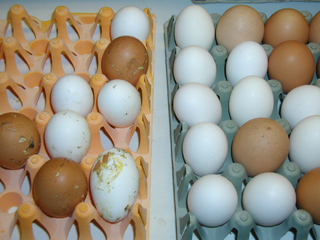G1724
Egg Cleaning Procedures for the Backyard Flock
This publication provides guidance on washing eggs for eating rather than hatching.
Kody M. Sok, Poultry Extension Assistant
Sheila E. Scheideler, Poultry Extension Specialist
|
Producing your own eggs can be a rewarding part of raising your own chickens. However, household poultry flocks can produce a high percentage of dirty or tainted eggs (Figure 1). Most of these eggs are soiled because they were laid in dirty nests or on the floor where they may have come in contact with fecal matter. Dirty eggs can be a health hazard if they are not properly washed and sanitized (i.e. harmful bacteria can enter through the pores of the eggs and if not cooked properly have the potential to cause food poisoning).
Prevention is the best control to reduce the number of dirty eggs. Most eggs coming from nests should be clean if the nesting materials are kept clean. The production of floor eggs can be minimized if the flock is trained early to use its nest boxes. When the pullets are 16-18 weeks of age, start introducing nest boxes and make sure to add bedding material such as straw, wood shavings, etc. to the bottom of the nest boxes. By week 20, a few fake eggs can be added into the nests to train the hens displaying nesting behavior to use the nest box. Some notable nesting behaviors are: pacing with the vent low to the ground, acting like she is looking for something or sitting tight in a corner. The hen can be caught and placed in a nest. She may or may not stay when placed there, but she will know that there is a nest. Hens like a little privacy in which to lay an egg. There should be a nest available for every four to five hens.
Eggs should be gathered at least once a day or more often. The longer eggs are left in nests, the more likely they may be broken or dirtied. Nests should be cleaned once a week to remove dirty litter and manure, and replaced with clean bedding materials (Figure 2).
Even under the best conditions, some dirty eggs may still result. Dirty eggs should be placed in a separate container so they don’t contaminate clean eggs.
Dirty eggs should be washed in water that is at least 20°F (11°C) warmer than the eggs. A good water temperature is 90-120°F (32.2-49°C), or as hot as the hands can tolerate for about 30 seconds or until the egg has been cleaned. This is so the contents of the egg will expand and “push” out any invading microbes.
It is recommended to use a nonfoaming, unscented detergent with which to wash the eggs. Eggs can absorb fragrance from a scented detergent, resulting in an off flavor. Unscented automatic dishwater or laundry detergent can be used. Wear rubber gloves as these materials can irritate the skin. After the initial wash, bleach can be used as a sanitizing dip with a ratio of 1 tablespoon bleach to a gallon of hot water, followed by a rinse.
 |
 |
 |
Typical nest |
Nest with broken egg |
Clean nest |
| Figure 2. | ||
How to Wash Eggs
|
If only a few eggs, washing can be done in a sink with hot water. The water and the sanitizer should be as hot as the hands can tolerate. Larger numbers of eggs require more attention.
Make up basins of detergent, rinse water and sanitizer, each containing 1 to 2 gallons of solution. Change the detergent and rinse water after every three to four dozen eggs. The temperature of each solution should be no more than 90-120°F (32.2-49°C). Rubber gloves will help hands tolerate the hot water. This should not result in hard-boiling or cooking the eggs, as they shouldn’t be in the hot water longer than it takes to wash them quickly.
Proper washing and sanitation reduces the risk of eggs spoiling, and also food poisoning. Wash eggs individually, but do not soak in solutions. After the initial wash, rinse eggs in clean water, then dip into the sanitizer and set aside to dry (Figure 3). Clean eggs can be dipped into the sanitizer if desired. Dry eggs should be promptly refrigerated to reduce risk of food poisoning. Store larger end up to retain maximum storage capacity. Used egg cartons or egg flats work great, but avoid keeping close to strong odorous products (i.e. fish, onions, garlic, etc.) as eggs may absorb those flavors.
Egg Washing Temperatures
For more information on egg washing see the USDA’s Egg Grading Manual online at: http://www.ams.usda.gov/Poultry/pdfs/EggGrading%20manual.pdf.
Sale of Eggs
In the state of Nebraska a producer that has 3,000 or fewer hens is not required to have an annual inspection license or pay an inspection fee. More information on egg grading regulations can be found on the Nebraska Department of Agriculture Web site: http://www.agr.state.ne.us/regulate/daf/egg_act.htm.
Visit the University of Nebraska–Lincoln Extension Publications Web site for more publications.
Index: Poultry
Management
Issued June 2007

